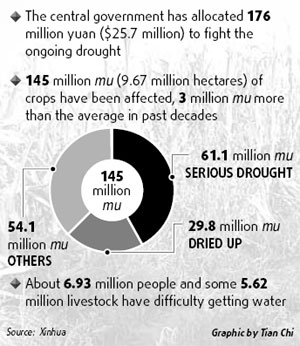|
![A farmer in Wengniute Banner in north China's Inner Mongolia takes a close look at his dried-out field of crops in the drought-hit region on Aug 20. The drought is being described as the area's most severe for 100 years. [China Daily] A farmer in Wengniute Banner in north China's Inner Mongolia takes a close look at his dried-out field of crops in the drought-hit region on Aug 20. The drought is being described as the area's most severe for 100 years. [China Daily]](http://images.china.cn/attachement/jpg/site1007/20090829/0011111fa1560c02cc7407.jpg)
|
|
?A farmer in Wengniute Banner in north China's Inner Mongolia takes a close look at his dried-out field of crops in the drought-hit region on Aug 20. The drought is being described as the area's most severe for 100 years. [China Daily] |
A fast-spreading drought has decreased drinking water supplies for nearly 7 million people and damaged crops in seven provinces and regions in central and northern China, the national anti-drought administration said.
Official statistics showed the drought had caused water shortages for 6.93 million people and 5.62 million head of livestock by Thursday.
Meanwhile, 145 million mu (9.67 million hectares) of crops have been affected - 3 million mu more than the average during the past few decades.
The overall scenario is serious because the drought is spreading fast due to low rainfall and lingering high temperatures, anti-drought officials said.
In the south, drought has hit in Hunan, Hubei and Guizhou provinces and the Guangxi Zhuang autonomous region, due to a record-high temperature in the past two weeks.
Between Aug 15 and 25, six provinces in the south experienced 5.7 days with an average temperature of more than 35 C. Meteorologists said this is the longest record since 1960, as the area usually has only two days of temperatures that high during that time period, China News Service reported.
"Though it won't damage crops, the drought will cause problems for some people and livestock to get drinking water," Lu Juan, deputy head of Department of Water Hazard Research with China Institute of Water Resources and Hydropower Research, told China Daily on Friday.
In the north, drought is getting serious from Jilin and Liaoning provinces in northeast China to the grasslands of Inner Mongolia in north China.

"The rainfall in Inner Mongolia has been barely enough for grass to grow", and both people and livestock are facing a serious shortage of drinking water, Lu Juan said.
Liaoning and Jilin, two of China's grain production bases, have also been hit hard by drought, and are likely to face a reduction in grain yield, such as corn and beans, she said.
Pan Shuhe, a farmer from Beipiao town of Liaoning, told China Daily that 80 percent of his farmland, measuring 8-mu, will not produce anything because of drought. The city of Chaoyao, which Beipiao belongs to, is the hardest hit in Liaoning.
Since crops in one mu of farmland typically earn almost 1,000 yuan (US$147), Pan said he could lose as much as 8,000 yuan.
His family will have to rely on grains stored earlier. And since no one is sure whether the city government will give them subsidies, many young people have left home to work in cities, he said.
Agricultural officials estimated that the grain yield in Fuxin of Liaoning would only reach half of that in the past, while the yield in Chaoyang would only manage to reach 20 to 30 percent of the usual level.
An official with the water resource department of Liaoning province, who gave his surname as Luo, said the department has sent teams to help farmers fight drought.
"There were rains on Wednesday. We had attached high hopes to it, but its coverage and rainfall were both too small to ease the drought," he said.
To help relief work in these disaster-hit areas, the Ministry of Finance and the Ministry of Civil Affairs appropriated a total of 176 million yuan (US$25.7 million) on Friday to fight the ongoing drought.
The money will be used in resolving grain and drinking water difficulties in drought-afflicted Hebei, Shanxi, Heilongjiang and Gansu provinces, along with Ningxia and Xinjiang Uygur autonomous regions.
Funding will also go toward reconstruction of collapsed houses in typhoon-hit Zhejiang province and heavy-rain-lashed Chongqing Municipality.
Drought has been plaguing the country since the beginning of this year. In early summer, the drought reached a peak, with 191 million mu of farmland affected.
(China Daily August 29, 2009)